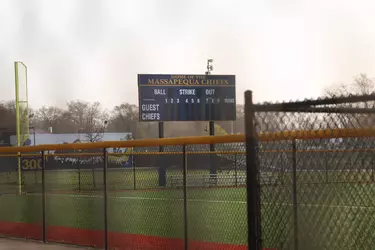
President Trump has expressed support for parents and students in Massapequa, N.Y., who want to retain a mascot that state officials want banished. Heather Khalifa for The New York Times
By Troy Closson
May 30, 2025, 12:39 p.m. ET
The U.S. Department of Education accused New York officials on Friday of discriminating against Native Americans by banning school mascots that draw from their culture.
The move was an expansion of the Trump administration’s efforts to punish states and public school districts for liberal stances on contentious education issues, and reflects a marked shift in the federal government’s interpretation of civil rights law.
The administration’s announcement came five weeks after President Trump publicly expressed his support for parents and students in Massapequa, N.Y., in their fight against a state Board of Regents requirement that school districts banish mascots based on Native American culture by this summer or risk losing state funding.
The Education Department had opened a civil rights investigation into the ban shortly after Mr. Trump weighed in.
The ban had set off a backlash in Massapequa, a middle-class hamlet on Long Island’s South Shore about 40 miles from Manhattan. Most residents voted for Mr. Trump last November.
The school district has used the “Chief” nickname and logo for decades. The mascot’s image, an illustrated side profile of a Native American man wearing a feathered headdress, is plastered across Massapequa campuses, welcome signs and football fields.
The Trump administration’s finding came after a particularly speedy version of what are typically lengthy inquiries. The Education Department’s Office for Civil Rights often takes months to identify violations of Title VI of the Civil Rights Act of 1964, which prohibits the recipients of federal funds from discriminating based on race, color or national origin.
Such investigations seldom result in the loss of federal funds, and the Trump administration did not immediately threaten New York’s bottom line. But the federal government has increasingly targeted public school and university ledgers.
The administration recently reached a deal with Maine to restore federal money for its public schools, after education officials initially moved to slash school aid because the state allows transgender athletes on girls’ sports teams.
New York was the state least reliant on federal funding for its public schools in 2022, according to the most recent nationwide data. Federal money accounts for less than 8 percent of the state’s overall spending on public education.
New York education officials described the mascot ban as part of an effort to promote diversity, equity and inclusion in schools. It came amid a broader national movement to eliminate logos and nicknames that Native American people may find disrespectful. Many tribes in New York support the state’s policy.
But the federal Education Department decided that the policy amounted to discrimination.
On Friday, Linda McMahon, the education secretary, traveled to Massapequa High School to speak with students and administrators who said the mascot was meant to convey respect.
Ms. McMahon said the department would demand that New York offer a formal apology to Massapequa, allow the district to maintain the Chief nickname and permit other schools to choose their preferred mascots.
She added that she was alarmed that New York would deny Massapequa the chance to celebrate its heritage, and accused the state of unfairly targeting Native American representation in education.
“This is a racist environment,” she said at a news conference at the high school, adding that if New York did not comply, her department would refer the case to the Justice Department “because that’s how serious we are.”
JP O’Hare, a spokesman for the state Education Department, did not immediately respond to a request for comment.
But Mr. O’Hare said last month that state and federal courts have upheld the department’s authority to prohibit the mascots, and noted that the state’s ban makes an exception for the continued use of Native American mascots if they are approved by local tribal leaders.
This is a developing story and will be updated.
Source (Archive)
